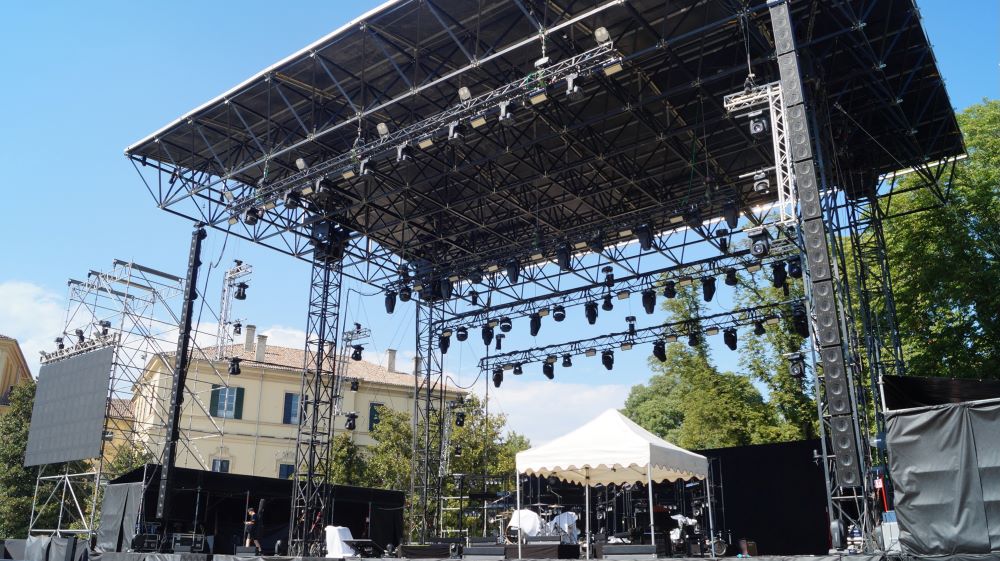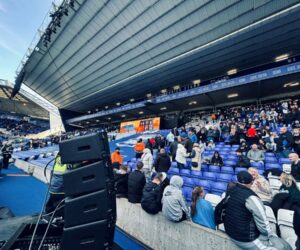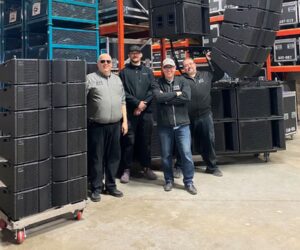The concert area of the Parma Parco Ducale (in the province of Parma, Italy) hosted numerous concerts this past summer, including performances from Andrea Bocelli, Zucchero, Sting and many others, supported by a sound reinforcement system utilizing K-array Firenze-KH7 as mains joined by Firenze-KS8 subwoofers.
The digital steering capabilities of the system proved useful in helping to contain sonic energy within the confines of the park without too much disturbance in the surrounding city. The system was deployed by production provider Arcadia Rent, headed by Riccardo Garbuglio, with support from K-array product specialist Klaus Hausherr, who also assisted all of the visiting mix engineers.
“We opted for a relatively standard configuration, with a left plus right [configuration] made up of eight Firenze-KH7 units, 10 Firenze-KS8 subs and additional KH7s in a horizontal position with the diffusion pattern rotate as reinforcement for the first rows,” say Hausherr.
The Firenze-KH7 can provide 30-degree vertical and 100-degree horizontal dispersion or 100-degree vertical and 30-degree horizontal diffusion with the diffuser rotated. The operation of rotation is quickly accomplished by turning the mechanism on the front of the cabinet, without removing the grille and without the use of tools.
“Having frontfills made up of the same units as the main system, even with the diffusion pattern rotated, offers a definite advantage in terms of sound coherence and simplicity of system set-up,” Hausherr adds.
Shows were staged with both seated and standing audiences, and as a result, a subwoofer configuration was conceived that would provide powerful and wide enough coverage to serve de-centralized areas of the venue. “We were able to open the spread of the subs up to an angle of 110 degrees while maintaining
excellent pressure throughout the venue,” he explains. “In concerts where there were seated audiences, it
was also necessary to provide adequate coverage in the areas to the edges of the stage, which are not always easy to serve.
“To hang each of Firenze-KH7’s eight-element clusters, we used simple motors of 500 kg capacity each, keeping the overall weight low enough to obtain approval from the Supervisory Commission to use the stage roof directly as an anchor point, which, moreover, underwent a major structural change just two days before assembly. With another traditional system, in all likelihood, this last-minute change would have required redesigning the sound system from scratch, sacrificing on loudspeakers in favor of less weight.”
While the loudspeakers can accept digital signal, analog interconnect was chosen for the sake of simplicity. Two pairs of cables — signal and power — fed the arrays, with simple relays of a few centimeters to daisy-chain the elements.
“I run the whole system with one signal for the left, one for the right, one line for all the Firenze-KS8 subs, and then one line for the three fronts and two for the sides, for a total of 10 output lines,” Hausherr says. “In addition, I reserve a final line for the management of another group of subs, not mentioned so far, which have the sole function of rear cancellation to recreate a cardioid configuration. A [Meyer Sound] Galileo processor with six inputs is used for control to satisfy the requests of all guest sound engineers who wanted to use separate management systems.”
Out of necessity, the main clusters were hung on the stage and in a somewhat backward position without generating any discomfort to the musicians. The rear lobe of Firenze-KH7, it can be clearly seen that the although present, proved narrow enough to not create any problems for anyone standing to the side of an array.
“I don’t deny that, at first glance, the system appears different, in shape and size to other systems,” Hausherr says. “For this reason, there are always those who tend to be wary. As soon as I start to play music, regardless of the genre, the first thing that strikes everyone is the incredible linearity and precision across the entire frequency range; an aspect that almost ‘disconcerts’ the sound engineers who find themselves with a mix that is rich in detail and definition, almost as if they were mixing on two studio monitors.”




















